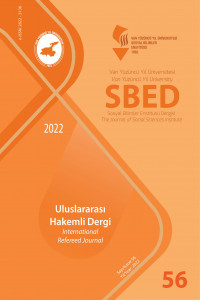Öz
Although the Armistice of Mondros was a truce, the Entente States began to invade different parts of Anatolia within the framework of the Oriental issue. Strategic locations such as cotton production in Çukurova, Mediter-ranean Ports and Taurus Tunnels increased France's interest in the region. England's tendency to economically richer geographies such as Mosul was also effective in this choice.The French deployed military forces to the Cukurova region in December 1918, shortly after the signing of the treaty. The fact that the French ignored the material and spiritual values of the Turkish nation along with the Armenians in the Cukurova region led to a reaction from the people of the region. The how Kaç-Kaç event contributed significantly to the direction and motivation of the resistance in the region. In particular, the people of Adana did not remain silent about the invasions and floods and started a large resistance movement in the region. The executive staff of the National Struggle has decided to establish Kuva-yı Milliye troops in the Çukurova region in order to act more organizati-onally in the face of invasions and people's resistance with the Sivas Congress. Captain Ali Ratip Bey from Edirne, who was referred to as ”Tekelioglu Sinan Bey" in this organization, took an important role in both the organization and the action phase. Mersin, Adana assumed military responsibility for the Garbi Cilicia Region, which includes Tarsus and the Seyhan River region. Sinan Bey Tekelioglu, 11. With the support of the Division, he dealt a major blow to the French in the Adana region. Tekelioglu, with his raids in the Pozantı region, deconst-ructed the coordination of the French troops among themselves, giving the Turkish forces a great advantage. The responsibility undertaken by Tekelioğlu Sinan Bey against the French occupation forces in the Çukurova region contributed significantly to the motivation of the resistance movements in the region. The resistance model in the Çukurova region served as a reference to the general course and planning of the National Struggle.
Kaynakça
- Cumhurbaşkanlığı Cumhuriyet Arşivi (BCA).030.10/77.506.11.
- ATASE, İstiklal Harbi Kataloğu, Kutu No:622,Gömlek No:174 Belge No:174-1.
- ATASE, İ.H.K, Kutu No:1060,Gömlek No:42,Belge No:42-1.
- ATASE, İ.H.K. Kutu No:767,Gömlek No:120 Belge No:120-1.
- ATASE, Kutu No:767,Gömlek No:121 Belge No:121-1.
- TBMM Arşivi Sinan Tekelioğlu Tercüme-i Hal Dosyası, No:51.
- Türk İnkılap Tarihi Arşivi (TİTE) Kutu: 20, Gömlek:67, Belge:3001.
Öz
Mondros Ateşkes Antlaşması, bir mütareke hükmünde olmasına karşın İtilaf Devletleri, Şark meselesi çerçevesinde Anadolu’nun farklı bölgelerini işgale başladılar. Çukurova’daki pamuk üretimi, Akdeniz Limanla-rı, Toros Tünelleri gibi stratejik mevkiiler Fransa’nın bölgeye yönelik ilgisini arttırdı. Bu tercihte İngiltere’nin Musul gibi ekonomik olarak daha zengin coğrafyalara yönelişi de etkili oldu. Fransızlar, antlaşmanın imzalan-masından kısa bir süre sonra Aralık 1918’de Çukurova bölgesine askeri kuvvet sevk ettiler. Fransızların Çuku-rova’da bölgesinde Ermeniler ile birlikte Türk milletinin maddi ve manevi değerlerini yok sayması, bölge halkı-nın tepkisine yol açtı. Kaç- Kaç olayı bölgedeki direnişin yönüne ve motivasyonuna ciddi katkı sağladı. Özellik-le Adana halkı işgallere ve taşkınlıklara sessiz kalmayarak bölgede büyük bir direniş hareketi başlattı. Milli Mücadele’nin yürütücü kadrosu, Sivas Kongresi ile işgaller ve halkın direnişi karşısında daha teşkilatlı hareket etme adına Çukurova bölgesinde Kuva-yı Milliye birlikleri kurma kararı aldı. Bu teşkilatlanmada Tekelioğlu Sinan Bey” takma adıyla anılan Edirneli Yüzbaşı Ali Ratip Bey, gerek teşkilatlanma gerek ise aksiyon safha-sında önemli rol üstlendi. Mersin, Adana Tarsus ve Seyhan Nehri bölgesini de içine alan Garbi Kilikya Bölge-si’nin askeri sorumluluk aldı. Tekelioğlu Sinan Bey, 11. Tümen'in desteğiyle Adana bölgesinde Fransızlara bü-yük darbe vurdu. Tekelioğlu, Pozantı bölgesinde yaptığı baskınlarla Fransız birliklerinin kendi aralarındaki koordinasyonunu keserek Türk kuvvetlerine büyük bir üstünlük kazandırdı. Tekelioğlu Sinan Bey’in, Çukuro-va bölgesinde Fransız işgal kuvvetlerine karşı üstlendiği sorumluluk bölgedeki direniş hareketlerinin motivasyo-nuna önemli katkı sağladı. Çukurova bölgesindeki direniş modeli Milli Mücadele’nin genel gidişatına ve plan-lamasına referans oluşturdu.
Anahtar Kelimeler
Kaynakça
- Cumhurbaşkanlığı Cumhuriyet Arşivi (BCA).030.10/77.506.11.
- ATASE, İstiklal Harbi Kataloğu, Kutu No:622,Gömlek No:174 Belge No:174-1.
- ATASE, İ.H.K, Kutu No:1060,Gömlek No:42,Belge No:42-1.
- ATASE, İ.H.K. Kutu No:767,Gömlek No:120 Belge No:120-1.
- ATASE, Kutu No:767,Gömlek No:121 Belge No:121-1.
- TBMM Arşivi Sinan Tekelioğlu Tercüme-i Hal Dosyası, No:51.
- Türk İnkılap Tarihi Arşivi (TİTE) Kutu: 20, Gömlek:67, Belge:3001.
Ayrıntılar
| Birincil Dil | Türkçe |
|---|---|
| Bölüm | Tam Sayı |
| Yazarlar | |
| Yayımlanma Tarihi | 30 Haziran 2022 |
| Gönderilme Tarihi | 1 Mayıs 2022 |
| Yayımlandığı Sayı | Yıl 2022 Sayı: 56 |
Yüzüncü Yıl Üniversitesi Sosyal Bilimler Dergisi Creative Commons Atıf-GayriTicari 4.0 Uluslararası Lisansı (CC BY NC) ile lisanslanmıştır.


